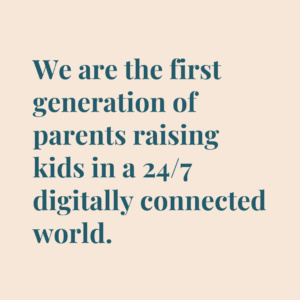Parents hear a lot about how screen time isn’t healthy for kids and teens. But how much is too much? And what’s the connection between screen time and risk of mental health diagnosis or even suicide?
Today’s kids and teenagers are part of what is sometimes called the iGeneration. They are the first generation to come of age in a world that is fully saturated by digital media, including smartphones. Our digital media-flooded world has had a significant transformation in how children and adolescents spend their time.
Kids today spend more of their free time with electronics than any previous generation. Think about the array of media that is available to them: TV (with unlimited on-demand streaming), video games, tablets, computers, and smartphones with constant access to the internet and social media.
Do kids still play?
All this screen time has created less time for more traditional childhood activities. Studies show that today’s kids spend less time outside and less time engaged in physical activity. They do less socializing in-person and face-to-face. Recently, the American Academy of Pediatrics issued a recommendation to doctors, urging them to prescribe playtime to children. They cited screen time as one key reason children are playing less. (I wrote recently about the AAP’s new recommendations on playtime for children, and why playtime is so essential for kids’ healthy emotional development.)
Digital media has risen to occupy an enormous place in daily life over the past couple of decades. We’re still just beginning to understand the impact of screens and new media on adults and children.
We know there are negative physical consequences for kids. Children who spend more time with electronics get less exercise. They’re more likely to be overweight and obese.
What about the consequences for kids’ mental health?
For scientists, that has been a complicated question to answer. New research is providing some much-needed clarity. Several studies draw strong connections between screen time and the risk of mental health problems in children and teenagers. Diagnoses of ADHD, anxiety, and depression are all more frequent in kids who spend more time with electronics.
Let’s take a closer look at what we’re learning about the effect of screens on the psychological well being of children—and their risks of being diagnosed with a mental health condition.
Screens increase kids’ anxiety and depression
A new, large-scale study set out to answer a big, important question: how does screen time affect psychological well being throughout childhood?
To answer that, scientists gathered information from a nationally-representative sample of children ages 2-17.
There are a number of things I like about this study.
First, they included a full range of electronics in their measurement of screen time: cell phones, computers, electronic devices, games, and television. Scientists also looked at the effect of screens not only on symptoms of psychological issues but also on diagnoses of anxiety and depression.
What did they find?
Overall, children were using screens for an average of slightly more than three hours a day. Time with electronics rose with age: among high-schoolers, the average was more than four hours daily.
This study found kids who used electronics more than one hour a day experienced diminished well being and more psychological distress.
They were:
- More likely to be agitated, to argue with their parents.
- More distracted, and more likely to give up on tasks before completing them
- Less curious about the world around them
They had less self-control and less emotional stability. And kids with screen habits beyond an hour a day had a harder time making friends.
How does screen time impact growth and development?
At different ages, kids showed distinct responses to regular doses of screen time. Among preschoolers, screen time had a significant impact on self-control. Preschoolers who were moderate and heavy users of screens had a tougher time sitting still, paying attention, and finishing tasks in front of them. They struggled with perseverance in ways that kids who had limited screen time (or none at all) did not.
These younger children were also more likely to lose their temper and to be anxious or angry when they needed to switch their focus from one activity to another.
The negative psychological effects of screen time were even more significant among older kids. Teens logged more daily screen time than younger children. Teens who were moderate electronics users (4 hours a day) and heavy users (7 or more hours a day) were much more likely to be diagnosed with anxiety and depression. Among the heavy user group, teens were more than twice as likely to:
- Be diagnosed with depression or anxiety
- Be treated by a mental health professional
- Be taking medication for behavioral or psychological issues
Medication is commonly the first option to treat depression and anxiety. I’ve spent some time writing about the shaky evidence of these drugs’ effectiveness—and their risks and dangers for kids.
Why do effects escalate for teens? It’s likely because their access to digital media expands, particularly after they have access to smartphones. (I’ll talk more about teens and smartphones in a minute.)
It is important to note …
Scientists in this study found a pretty clear cut off point in the amount of daily screen time kids could have before suffering negative consequences.
Children who used electronics for an hour or less per day had the same levels of well being and the same frequency of anxiety and depression as children who weren’t exposed to screens at all.
Anything over an hour per day and the unhealthy psychological effects of electronic use began to increase.
This study on its own can’t tell us everything we need to know about screens and psychological health in our kids. But it does represent a real step forward in measuring the impact of electronics on mental health. There is other research out there with similar conclusions … when the frequency of screen time increases, a decrease in children’s psychology takes place.
What about ADHD and screen time?
Think about the challenges that screens pose for you as an adult. The stimulation distracts our focus and pulls our attention away from tasks. When we’re absorbed in screens, whether TVs, computers, or smartphones, we’re less apt to engage with other people socially. The constant—and instant—delivery of information and entertainment can make us impatient, anxious and irritable.
Now imagine all that stimulation and distraction on a child, with a still-developing brain. Throughout childhood, our children are developing their capacity for attention, self-control, and emotional regulation.
Like other forces in a child’s environment, screen time and media exposure can affect their brain development and behavior. Struggles with attention, impulsiveness, aggression, and hyperactivity, and difficulty managing social behavior are exacerbated by screens and digital media, according to research. Constant feedback from devices can interfere with the development of impulse control, organizational skills, and focus. When these behaviors pose issues in children, the result is often a diagnosis of ADHD. Medication is often the treatment plan for ADHD, along with the risks and side effects that those medications pose.
What symptoms arise with increased screen time?
New research found that digital media use among teens increases their risks of developing ADHD symptoms. This study focused on a group of 15 and 16-year-old high-school students in the Los Angeles area. At the start of the study, the kids showed no symptoms of ADHD. Researchers found that the more teens used digital media, the higher their chances were to develop trouble with focus, difficulty completing tasks, emotional outbursts, and other symptoms linked to ADHD. And, the more forms of media the teens used, the more their risk for the cluster of ADHD symptoms went up. The highest users of electronic media were more than twice as likely to develop ADHD symptoms over the next two years.
Digital media continues to transform itself quickly. There is a lack of research into how screens and their media content affect children’s brains and behavior in ways that may put them at risk for a diagnosis of ADHD. This research strongly suggests digital media use is a contributing ADHD cause.
Teens, smartphones, depression, and suicide
Here’s a fact that won’t surprise parents of teenagers. Their most common digital media habit is regularly checking social media. Most teens these days have smartphones. That gives them largely unchecked exposure to screens and access to social media that can be difficult for parents to monitor.
Social media, in particular, is a powerful, pervasive force in adolescent life. It gives them the ability to “socialize” with their peers constantly—both one-on-one and in large groups– through instant, unfiltered communications. Teens’ social lives provide a critical terrain for their emotional, behavioral, and intellectual growth.
Teen suicide
The addition of smartphones into kids’ lives often happens right at the time when socializing becomes a huge deal. The combination of teens natural inclination to be social and access to digital media has brought two powerful forces together for today’s teenagers, in a way no previous generation has experienced. That’s causing significant changes to how teens spend their time. And it is exposing them to more significant mental health risks, including depression and suicide.
An important new study documents the effects of screens and social media on mental health and suicide in teenagers. Researchers have found an unprecedented rise in depression, suicidal thoughts, and death in teenagers that’s occurred in the past decade. The study found a marked increase for these issues in girls. Between 2010 and 2015, an additional 33 percent of U.S. teens experienced symptoms of depression. More than 31 percent died by suicide than in previous years. During this time, more teens experienced feelings of hopelessness and suicidal thoughts.
An alarming increase in depression and suicide
These alarming increases occurred during the same years when digital media use among teens exploded. By 2012, more than 90 percent of adolescents had their own smartphone. This study found teens’ screen time rose during 2010-2015. At the same time, they spent significantly less time engaged in non-screen activities. Those “non-screen activities” include routines that teenagers have engaged in for many generations: homework, in-person socializing, volunteering, participating in religious communities, playing sports, reading books.
The study analyzed the possible relationship between the bump in digital media habits and the increase in depression and suicide. Researchers made some important discoveries:
- Teens who spent more time with screens were more likely to be depressed, feel hopeless, and die by suicide
- The more time they spent with digital devices, the higher their risks for mental health problems became. Teenagers who spent 3 hours a day or more with screens were 34 percent more likely to feel hopeless than kids who used screens for less than 2 hours a day.
- Social media, in particular, was connected to more depression and suicide risk among teenagers. Like with general screen use, the effect was stronger for girls.
- A combination of low in-person social contact and high social media use created especially significant risk for depression in teenagers
This isn’t the only study to demonstrate the negative relationship of smartphones and social media to depression, suicide risk, and other mental health issues. Other research has drawn similar connections. Excessive phone use in teens is related to chronic stress and emotional upheaval. Lots of social media time leads to lower psychological well being. Limiting digital media increases feelings of well being.
What are we seeing here in this latest crop of research?
A pattern of screens and digital media disrupting traditional activities for kids and teens that have fostered their development. A connection between these newer, electronic-based habits and declines in teens’ mental health. An increase in diagnoses of depression, anxiety, ADHD and other conditions. A clear picture that screen time really does matter. These are all important factors for parents to consider when thinking about the screen access they give their children.
The course of mental health and development during childhood will affect our kids today, and throughout their lives. Limiting and managing screen time is one powerful way to ease their risks, and help them grow to be healthy adults.
What can you do?
Manage your own screen time. Parents can be a model for their kids in how to live a full life apart from electronics. Minimize the time you spend on your phone or other screens when you’re around your children.
Give kids non-screen options. It’s not enough to tell kids they can’t use electronic devices on demand, or outside specific windows of time, you designate. Limiting screens becomes a whole lot easier and more successful when parents provide access to engaging, non-screen activities. Don’t just say no to screens and expect your child or teen to find their own substitute activity. Head to the park together. Sit down on the floor and play a game. Volunteer at a local animal shelter or food bank. Arrange regular times for kids to play in person with other kids.
Watch the middle school years. Research shows there can be a big jump in kids screen time and digital media use between elementary school and middle school. Kids are behaving more like older children. They’re also likely putting the pressure on parents for more independence with their digital lives. That includes wanting their own phones. This transitional time is one for parents to monitor closely, to help keep kids’ screen use in check.
Emphasize face-to-face social time. I can’t stress enough how important this is for kids of all ages. At every developmental stage, socializing with peers in person provides a deep well of benefits for children. Socializing together is also protective—we know from studies (as well as our own lived experience) that in-person socializing helps to guard against loneliness.
Collaborate with teens. There is no getting around it. Negotiating with teens over their digital media habits is not easy. Try not to approach it as adversaries. Work together, on the same side, to come up with limits. And talk with your teens about why these limits matter to their health. The more they understand about the more profound consequences, the more likely they are to want to live within the boundaries you’ve set together.
For more on this topic, check out my article on Screen Time Can Be Dangerous for Kids’ Mental & Physical Health.
What You Should Do Next:
Sign up for my Better Behavior Naturally community newsletter
Sign up for my newsletter to get tips, resources, and supports to improve your child’s attention, anxiety, mood, and behavior…while making your job as a parent easier.
Enroll in one of my workshops
Check out one of my many workshops where you’ll join my exclusive community of parents in a one-of-a-kind virtual resource accessible 24/7. Whether you’ve got a child with a diagnosis like autism or ADHD, or are becoming more and more frustrated with a child who struggles to listen and cope, these workshops are designed to give you the information, tools, and support you need…whenever you need it.








